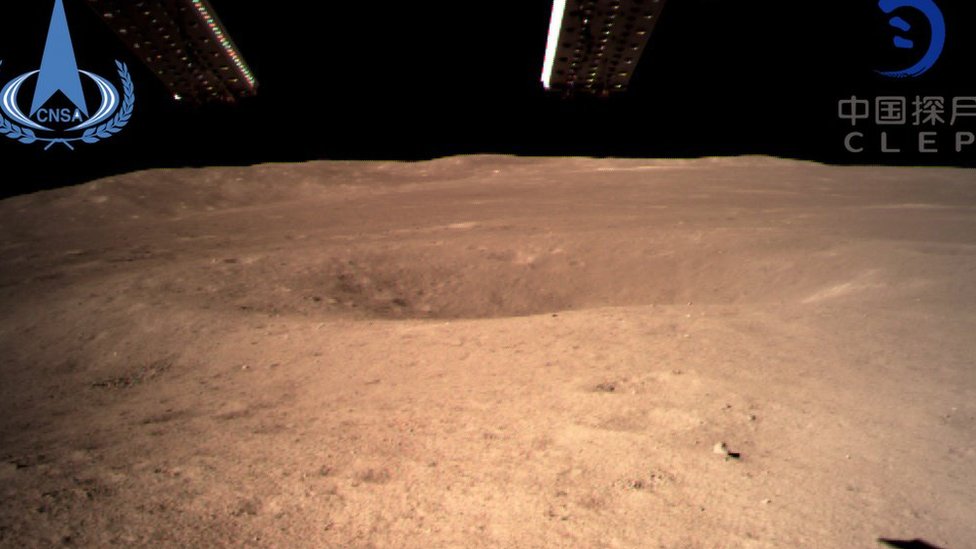
Image copyrightCNSA/AFPImage caption The first close up pictures of the far side of the Moon What will China's Chang'e-4 mission learn about the far side of the Moon Here are a few things the mission is designed to do.Learn about the Moon's historyNo space mission has ever explored the far side from the surface.
As such, it's the first chance to explore a mysterious region of Earth's natural satellite.
The "face" that's never seen from Earth has some key differences to the more familiar "near side".
The far side has a thicker, older crust that is pocked with more craters.
There are also very few of the "maria" (dark basaltic "seas" created by lava flows) that are evident on the near side.Chang'e-4 has reportedly landed at a site known as Von Krmn crater, a 180km depression located in the far side's southern hemisphere.
But Von Krmn lies within a much bigger hole punched in the Moon - the South Pole-Aitken basin.It's the oldest, largest and deepest such basin on the Moon and formed when an asteroid - perhaps 500km across, or more - collided with it billions of years ago.
This event was so powerful that it is thought to have ploughed through the Moon's outer crust layer and through into the zone known as the mantle.One of the mission's objectives is to study any exposed material from the mantle present at the landing site.
This would provide insights into the internal structure and history of the Moon.Image copyrightNASAImage caption The South Pole-Aitken basin was formed by a giant impact billions of years ago Indeed, data from orbiting spacecraft show that the composition of the basin is different from the surrounding lunar highlands.
But exposed mantle material on the surface is just one possibility among several to explain this observation.The rover will use its panoramic camera to identify interesting locations and its Visible and Near-Infrared Imaging Spectrometer (VNIS) to study minerals in the floor of the crater (as well as of ejecta - rocks thrown out by nearby space impacts).Additionally, the Lunar Penetrating Radar (LPR) instrument will be able to look into the shallow subsurface of the Moon, down to a depth of about 100m.
It could probe the thickness of the lunar regolith - the broken up rocks and dust that make up the surface - and shed light on the structure of the upper lunar crust.After the huge impact that created the South Pole-Aitken basin, a large amount of melted rock would have filled the depression.
The science team wants to use Chang'e-4 to identify and study variations in its composition.Filling an astronomy gapThe far side of the Moon has long been regarded as an ideal spot for conducting a particular kind of radio astronomy - in the low-frequency band - because it's shielded from the radio noise of Earth.
There's a frequency band (below about 10MHz) where radio astronomy observations can't be conducted from Earth, because of manmade radio interference and other, natural factors.Chang'e-4's lander is carrying an instrument called the Low Frequency Spectrometer (LFS) which can make low frequency radio observations.
It will be used in concert with a similar experiment on the Queqiao orbiting satellite.The objectives include making a map of the radio sky at low frequencies and studying the behaviour of the Sun.Speaking in 2016, Liu Tongjie, from the Chinese space agency (CNSA), said: "Since the far side of the Moon is shielded from electromagnetic interference from the Earth, it's an ideal place to research the space environment and solar bursts, and the probe can 'listen' to the deeper reaches of the cosmos."Thus, the mission will fill a gap in astronomical observation, allowing scientists to study cosmic phenomena in a way that has never been possible from our planet.Radiation on the MoonImage copyrightScience Photo LibraryImage caption Understanding the radiation environment will be vital for future human exploration Several space agencies want to land humans on the Moon in the not-too-distant future, and might send astronauts there for longer than we've ever stayed before.
So understanding the potential risks from radiation are vital.Earth's thick atmosphere and strong magnetic field provide adequate shielding against galactic cosmic rays and energetic charged particles travelling from the Sun.
But astronauts on the Moon will be outside this protective bubble and exposed to particles travelling through open space at near the speed of light - with potentially damaging consequences for their health.The Lunar Lander Neutrons and Dosimetry (LND) experiment, supplied by researchers in Germany, will aim to fill in some gaps in our understanding about the lunar radiation environment.It will provide dosimetry (measure the ionising radiation dose that could be absorbed by the human body) with a view to future exploration, and contribute to understanding of particles originating from the Sun.Follow Paul on Twitter.

 9
9







